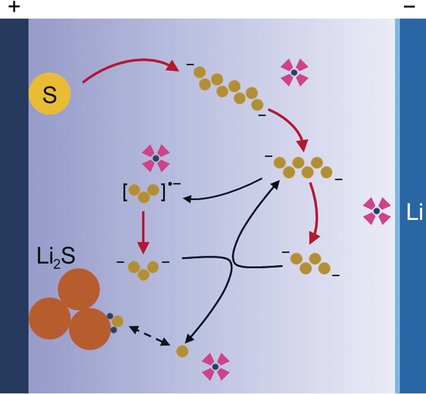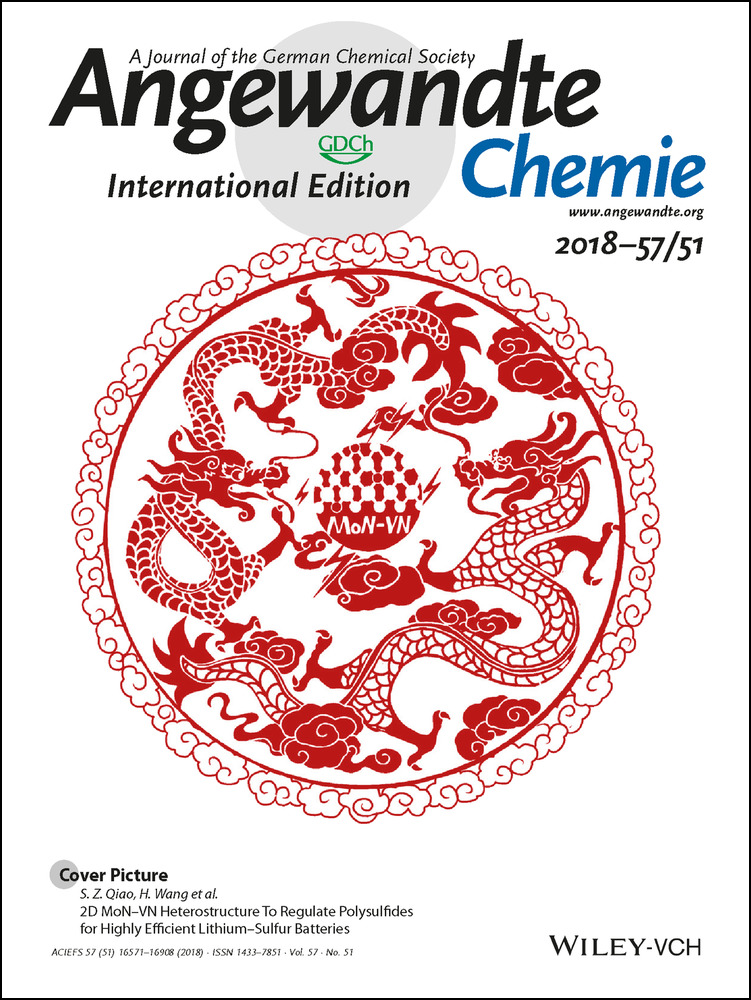The Radical Pathway Based on a Lithium-Metal-Compatible High-Dielectric Electrolyte for Lithium–Sulfur Batteries
Ge Zhang
Beijing Key Laboratory of Green Chemical Reaction Engineering and Technology, Department of Chemical Engineering, Tsinghua University, Beijing, 100084 P. R. China
These authors contributed equally to this work.
Search for more papers by this authorDr. Hong-Jie Peng
Beijing Key Laboratory of Green Chemical Reaction Engineering and Technology, Department of Chemical Engineering, Tsinghua University, Beijing, 100084 P. R. China
These authors contributed equally to this work.
Search for more papers by this authorChen-Zi Zhao
Beijing Key Laboratory of Green Chemical Reaction Engineering and Technology, Department of Chemical Engineering, Tsinghua University, Beijing, 100084 P. R. China
Search for more papers by this authorXiang Chen
Beijing Key Laboratory of Green Chemical Reaction Engineering and Technology, Department of Chemical Engineering, Tsinghua University, Beijing, 100084 P. R. China
Search for more papers by this authorLi-Da Zhao
Beijing Key Laboratory of Green Chemical Reaction Engineering and Technology, Department of Chemical Engineering, Tsinghua University, Beijing, 100084 P. R. China
Search for more papers by this authorPeng Li
Beijing Key Laboratory of Green Chemical Reaction Engineering and Technology, Department of Chemical Engineering, Tsinghua University, Beijing, 100084 P. R. China
Search for more papers by this authorProf. Jia-Qi Huang
Advanced Research Institute of Multidisciplinary Science, Beijing Institute of Technology, Beijing, 100081 P. R. China
Search for more papers by this authorCorresponding Author
Prof. Qiang Zhang
Beijing Key Laboratory of Green Chemical Reaction Engineering and Technology, Department of Chemical Engineering, Tsinghua University, Beijing, 100084 P. R. China
Search for more papers by this authorGe Zhang
Beijing Key Laboratory of Green Chemical Reaction Engineering and Technology, Department of Chemical Engineering, Tsinghua University, Beijing, 100084 P. R. China
These authors contributed equally to this work.
Search for more papers by this authorDr. Hong-Jie Peng
Beijing Key Laboratory of Green Chemical Reaction Engineering and Technology, Department of Chemical Engineering, Tsinghua University, Beijing, 100084 P. R. China
These authors contributed equally to this work.
Search for more papers by this authorChen-Zi Zhao
Beijing Key Laboratory of Green Chemical Reaction Engineering and Technology, Department of Chemical Engineering, Tsinghua University, Beijing, 100084 P. R. China
Search for more papers by this authorXiang Chen
Beijing Key Laboratory of Green Chemical Reaction Engineering and Technology, Department of Chemical Engineering, Tsinghua University, Beijing, 100084 P. R. China
Search for more papers by this authorLi-Da Zhao
Beijing Key Laboratory of Green Chemical Reaction Engineering and Technology, Department of Chemical Engineering, Tsinghua University, Beijing, 100084 P. R. China
Search for more papers by this authorPeng Li
Beijing Key Laboratory of Green Chemical Reaction Engineering and Technology, Department of Chemical Engineering, Tsinghua University, Beijing, 100084 P. R. China
Search for more papers by this authorProf. Jia-Qi Huang
Advanced Research Institute of Multidisciplinary Science, Beijing Institute of Technology, Beijing, 100081 P. R. China
Search for more papers by this authorCorresponding Author
Prof. Qiang Zhang
Beijing Key Laboratory of Green Chemical Reaction Engineering and Technology, Department of Chemical Engineering, Tsinghua University, Beijing, 100084 P. R. China
Search for more papers by this authorGraphical Abstract
Li−S batteries: A lithium-compatible and strongly polysulfide-solvating high-dielectric electrolyte based on tetramethylurea was proposed to direct a solvation-mediated radical reaction pathway. It enables Li−S pouch cells to deliver an energy density of 324 Wh kg−1. Key: red=electrochemical, black=chemical, dashed=diffusion/precipitation.
Abstract
High-dielectric solvents were explored for enhancing the sulfur utilization in lithium–sulfur (Li−S) batteries, but their applications have been impeded by low stability at the lithium metal anode. Now a radical-directed, lithium-compatible, and strongly polysulfide-solvating high-dielectric electrolyte based on tetramethylurea is presented. Over 200 hours of cycling was realized in Li|Li symmetric cells, showing good compatibility of the tetramethylurea-based electrolyte with lithium metal. The high solubility of short-chain polysulfides, as well as the presence of active S3.− radicals, enabled pouch cells to deliver a discharge capacity of 1524 mAh g−1 and an energy density of 324 Wh kg−1. This finding suggests an alternative recipe to ether-based electrolytes for Li−S batteries.
Supporting Information
As a service to our authors and readers, this journal provides supporting information supplied by the authors. Such materials are peer reviewed and may be re-organized for online delivery, but are not copy-edited or typeset. Technical support issues arising from supporting information (other than missing files) should be addressed to the authors.
| Filename | Description |
|---|---|
| anie201810132-sup-0001-misc_information.pdf2.3 MB | Supplementary |
Please note: The publisher is not responsible for the content or functionality of any supporting information supplied by the authors. Any queries (other than missing content) should be directed to the corresponding author for the article.
References
- 1X. B. Cheng, R. Zhang, C. Z. Zhao, Q. Zhang, Chem. Rev. 2017, 117, 10403–10473; D. C. Lin, Y. Y. Liu, Y. Cui, Nat. Nanotechnol. 2017, 12, 194–206.
- 2Y. X. Yin, S. Xin, Y. G. Guo, L. J. Wan, Angew. Chem. Int. Ed. 2013, 52, 13186–13200; Angew. Chem. 2013, 125, 13426–13441; Z. W. Seh, Y. M. Sun, Q. F. Zhang, Y. Cui, Chem. Soc. Rev. 2016, 45, 5605–5634; R. P. Fang, S. Y. Zhao, Z. H. Sun, W. Wang, H. M. Cheng, F. Li, Adv. Mater. 2017, 29, 1606823; H. J. Peng, J. Q. Huang, X. B. Cheng, Q. Zhang, Adv. Energy Mater. 2017, 7, 1700260; S. H. Chung, C. H. Chang, A. Manthiram, Adv. Funct. Mater. 2018, 28, 1801188.
- 3X. Liang, C. Hart, Q. Pang, A. Garsuch, T. Weiss, L. F. Nazar, Nat. Commun. 2015, 6, 5682; G. Q. Tan, R. Xu, Z. Y. Xing, Y. F. Yuan, J. Lu, J. G. Wen, C. Liu, L. Ma, C. Zhan, Q. Liu, T. P. Wu, Z. L. Jian, R. Shahbazian-Yassar, Y. Ren, D. J. Miller, L. A. Curtiss, X. L. Ji, K. Amine, Nat. Energy 2017, 2, 17090; Z. H. Sun, J. Q. Zhang, L. C. Yin, G. J. Hu, R. P. Fang, H. M. Cheng, F. Li, Nat. Commun. 2017, 8, 14627; Y. S. Ye, F. Wu, Y. T. Liu, T. Zhao, J. Qian, Y. Xing, W. L. Li, J. Q. Huang, L. Li, Q. M. Huang, X. D. Bai, R. J. Chen, Adv. Mater. 2017, 29, 1700598; S. H. Chung, A. Manthiram, Joule 2018, 2, 710–724.
- 4M. Hagen, D. Hanselmann, K. Ahlbrecht, R. Maca, D. Gerber, J. Tubke, Adv. Energy Mater. 2015, 5, 1401986; D. Eroglu, K. R. Zavadil, K. G. Gallagher, J. Electrochem. Soc. 2015, 162, A 982–A990.
- 5M. A. Pope, I. A. Aksay, Adv. Energy Mater. 2015, 5, 1500124.
- 6S. Waluś, C. Barchasz, R. Bouchet, J. C. Leprêtre, J. F. Colin, J. F. Martin, E. Elkaïm, C. Baehtz, F. Alloin, Adv. Energy Mater. 2015, 5, 1500165; H. J. Peng, J. Q. Huang, X. Y. Liu, X. B. Cheng, W. T. Xu, C. Z. Zhao, F. Wei, Q. Zhang, J. Am. Chem. Soc. 2017, 139, 8458–8466; F. Y. Fan, Y. M. Chiang, J. Electrochem. Soc. 2017, 164, A 917–A922.
- 7M. Cuisinier, P. E. Cabelguen, B. D. Adams, A. Garsuch, M. Balasubramanian, L. F. Nazar, Energy Environ. Sci. 2014, 7, 2697–2705; C. W. Lee, Q. Pang, S. Ha, L. Cheng, S. D. Han, K. R. Zavadil, K. G. Gallagher, L. F. Nazar, M. Balasubramanian, ACS Cent. Sci. 2017, 3, 605–613; A. Shyamsunder, W. Beichel, P. Klose, Q. Pang, H. Scherer, A. Hoffmann, G. K. Murphy, I. Krossing, L. F. Nazar, Angew. Chem. Int. Ed. 2017, 56, 6192–6197; Angew. Chem. 2017, 129, 6288–6293.
- 8M. Cuisinier, C. Hart, M. Balasubramanian, A. Garsuch, L. F. Nazar, Adv. Energy Mater. 2015, 5, 1401801.
- 9H. L. Pan, X. L. Wei, W. A. Henderson, Y. Y. Shao, J. Z. Chen, P. Bhattacharya, J. Xiao, J. Liu, Adv. Energy Mater. 2015, 5, 1500113.
- 10Q. L. Zou, Y. C. Lu, J. Phys. Chem. Lett. 2016, 7, 1518–1525; T. Chivers, P. J. W. Elder, Chem. Soc. Rev. 2013, 42, 5996–6005.
- 11G. Zhang, Z. W. Zhang, H. J. Peng, J. Q. Huang, Q. Zhang, Small Methods 2017, 1, 1700134.
- 12M. Hagen, P. Schiffels, M. Hammer, S. Dorfler, J. Tubke, M. J. Hoffmann, H. Althues, S. Kaskel, J. Electrochem. Soc. 2013, 160, A 1205–A1214.
- 13F. Y. Fan, W. C. Carter, Y. M. Chiang, Adv. Mater. 2015, 27, 5203–5209.
- 14H. J. Peng, G. Zhang, X. Chen, Z. W. Zhang, W. T. Xu, J. Q. Huang, Q. Zhang, Angew. Chem. Int. Ed. 2016, 55, 12990–12995; Angew. Chem. 2016, 128, 13184–13189.
- 15L. C. H. Gerber, P. D. Frischmann, F. Y. Fan, S. E. Doris, X. Qu, A. M. Scheuermann, K. Persson, Y. M. Chiang, B. A. Helms, Nano Lett. 2016, 16, 549–554.
- 16H. L. Pan, J. Z. Chen, R. G. Cao, V. Murugesan, N. N. Rajput, K. S. Han, K. Persson, L. Estevez, M. H. Engelhard, J. G. Zhang, K. T. Mueller, Y. Cui, Y. Y. Shao, J. Liu, Nat. Energy 2017, 2, 813–820.
- 17M. Cuisinier, P. E. Cabelguen, S. Evers, G. He, M. Kolbeck, A. Garsuch, T. Bolin, M. Balasubramanian, L. F. Nazar, J. Phys. Chem. Lett. 2013, 4, 3227–3232; M. Wild, L. O'Neill, T. Zhang, R. Purkayastha, G. Minton, M. Marinescu, G. J. Offer, Energy Environ. Sci. 2015, 8, 3477–3494.
- 18W. Y. Li, H. B. Yao, K. Yan, G. Y. Zheng, Z. Liang, Y. M. Chiang, Y. Cui, Nat. Commun. 2015, 6, 7436; C. Z. Zhao, X. B. Cheng, R. Zhang, H. J. Peng, J. Q. Huang, R. Ran, Z. H. Huang, F. Wei, Q. Zhang, Energy Storage Mater. 2016, 3, 77–84.
- 19Y. Gofer, Y. E. Ely, D. Aurbach, Electrochim. Acta 1992, 37, 1897–1899.
- 20P. Bai, J. Li, F. R. Brushett, M. Z. Bazant, Energy Environ. Sci. 2016, 9, 3221–3229.
- 21X. B. Cheng, C. Yan, X. Chen, C. Guan, J. Q. Huang, H. J. Peng, R. Zhang, S. T. Yang, Q. Zhang, Chem 2017, 2, 258–270.
- 22G. X. Li, Y. Gao, X. He, Q. Q. Huang, S. R. Chen, S. H. Kim, D. H. Wang, Nat. Commun. 2017, 8, 850; G. X. Li, Q. Q. Huang, X. He, Y. Gao, D. W. Wang, S. H. Kim, D. H. Wang, ACS Nano 2018, 12, 1500–1507.
- 23Q. L. Zou, Z. J. Liang, G. Y. Du, C. Y. Liu, E. Y. Li, Y. C. Lu, J. Am. Chem. Soc. 2018, 140, 10740–10748; H. L. Pan, K. S. Han, M. H. Engelhard, R. G. Cao, J. Z. Chen, J. G. Zhang, K. T. Mueller, Y. Y. Shao, J. Liu, Adv. Funct. Mater. 2018, 28, 1707234.
- 24X. D. Ren, S. R. Chen, H. Lee, D. H. Mei, M. H. Engelhard, S. D. Burton, W. G. Zhao, J. M. Zheng, Q. Y. Li, M. S. Ding, M. Schroeder, J. Alvarado, K. Xu, Y. S. Meng, J. Liu, J. G. Zhang, W. Xu, Chem 2018, 4, 1877–1892.
- 25M. D. Tikekar, S. Choudhury, Z. Y. Tu, L. A. Archer, Nat. Energy 2016, 1, 16114; G. Y. Zheng, S. W. Lee, Z. Liang, H. W. Lee, K. Yan, H. B. Yao, H. T. Wang, W. Y. Li, S. Chu, Y. Cui, Nat. Nanotechnol. 2014, 9, 618–623.
- 26R. Xu, J. Lu, K. Amine, Adv. Energy Mater. 2015, 5, 1500408.





